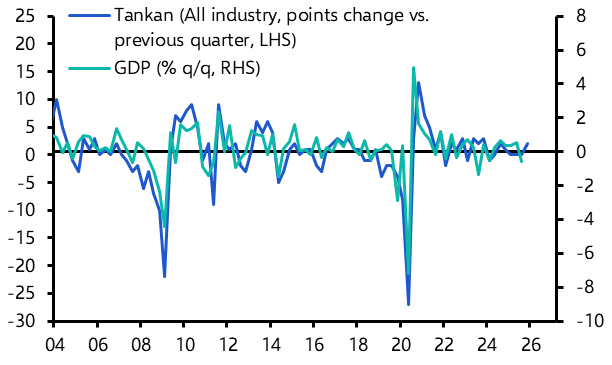After last Thursday’s ECB meeting, the focus will now shift to the Fed. A cut in interest rates at this week’s FOMC meeting is now widely expected and anything less would send shockwaves through bond and equity markets. Instead, the key question facing investors now is whether the Fed can get away with a small number of “insurance” cuts or whether it will be pushed towards a more fundamental loosening of policy.
The usual position adopted by central bankers is that future policy decisions should remain “data dependent”. Framing the outlook for monetary policy in this way is unhelpful at the best of times but particularly so now, given that the data are sending mixed signals.
GDP data released last week showed that second quarter growth in the US was a bit stronger than expected, thanks in large part to a healthy contribution from consumers. But the survey data have continued to deteriorate and point to a slowdown in growth over the second half of the year.
Forward looking indicators are similarly mixed. The rise in the New York Fed’s recession indicator to its highest level since the 2008 financial crisis has caused a stir in some quarters in recent weeks. But the New York Fed’s recession indicator is constructed using Treasury spreads and is only really telling us that the yield curve is partially inverted. Other leading indicators – such as that produced by the Conference Board – paint a less alarming picture.
Stepping back, the overall impression we’re left with is that of an economy that is losing momentum but not collapsing. We expect economic growth to slow to less than 1% annualised over the second half of this year. That’s enough to justify insurance cuts and, in the circumstances, it makes sense for the Fed to get ahead of the curve. But we suspect that most officials will want to see clearer evidence of a much deeper downturn before countenancing a more substantial loosening of monetary policy. We’re sticking to our view that the fed funds rate will be lowered by 75bps to 1.50-1.75 over the next six months or so.
Where might we be wrong? There is growing speculation that the Fed’s ongoing review of its monetary policy framework may be starting to influence the thinking of some FOMC participants, in effect pushing them in the direction of looser policy. But while the ground may be shifting at the Fed, this will play out over years not months. We suspect that developments in the real economy will remain the key driver of policy decisions over the coming quarters.
The case for more substantial easing of policy would become more convincing if, for example, we started to see a serious downturn in job gains or a sharp fall in consumer confidence. There is also a risk that financial conditions start to tighten. Chart 1 shows that over the past few months financial conditions have eased – in part due to the anticipation of Fed policy loosening. But if conditions began to tighten, perhaps because of an unexpected financial shock, this could justify more aggressive policy easing.
Chart 1: Capital Economics US Financial Conditions Indicator

Such an event wouldn’t necessarily come as a major surprise given that asset prices and debt levels are high but it doesn’t seem to be on the immediate horizon. Perhaps a bigger risk for now is that the scale of Fed easing falls short of the market expectations that have built in recent weeks, causing financial conditions to tighten and therefore pushing the Fed into additional loosening. In this respect, it’s possible that the feedback loop from Fed policy decisions to financial conditions makes further easing a self-fulfilling prophecy.
The situation in the euro-zone is rather different. For a start, the latest data suggest that the region’s economy is struggling more than is the case with the US. The flash PMIs for July (released last week) dashed hopes that the downturn in the activity data may be bottoming out and left the manufacturing PMI for Germany at a seven-year low. Admittedly, like the US, the euro-zone doesn’t seem to be facing an imminent recession. But the surveys suggest the economy is now growing at a rate of just 0.2% q/q and inflation is stuck well below the ECB’s target of “below but close to” 2%. Moreover, structural problems remain at the heart of the euro-zone that will tend to depress domestic demand over the long term.
All of this means that the argument in favour of a more fundamental loosening of monetary policy is more persuasive than it is in the US. Markets struggled to process the message from the ECB in the immediate aftermath of last week’s meeting – having published a relatively dovish statement alongside the decision to leave policy settings unchanged, Mario Draghi then appeared to dampen down expectations for policy loosening in his subsequent press conference.
Yet despite these mixed messages, we continue to expect a cut in interest rates when the ECB next meets in September – and for further easing to follow. Some members of the ECB’s governing council seem to harbour concerns about introducing a tiering system to offset the unwanted side effects of the negative deposit rate, but we still expect this to happen at some point in the coming months. More fundamentally, we expect the ECB to re-launch QE by the end of this year. Investors should prepare themselves for the Japanification of euro-zone monetary policy.
In case you missed it:
(Requires Login)
- Jennifer McKeown takes stock of the IMF’s latest set of forecasts – and explains why even after the recent downgrades they may still be too optimistic.
- Our US team looks ahead to this week’s jobs data and sees a labour market that’s beginning to sour.
- Our EM team has published its latest Financial Risks Monitor, which flags mounting banking sector vulnerabilities in Turkey and China.




